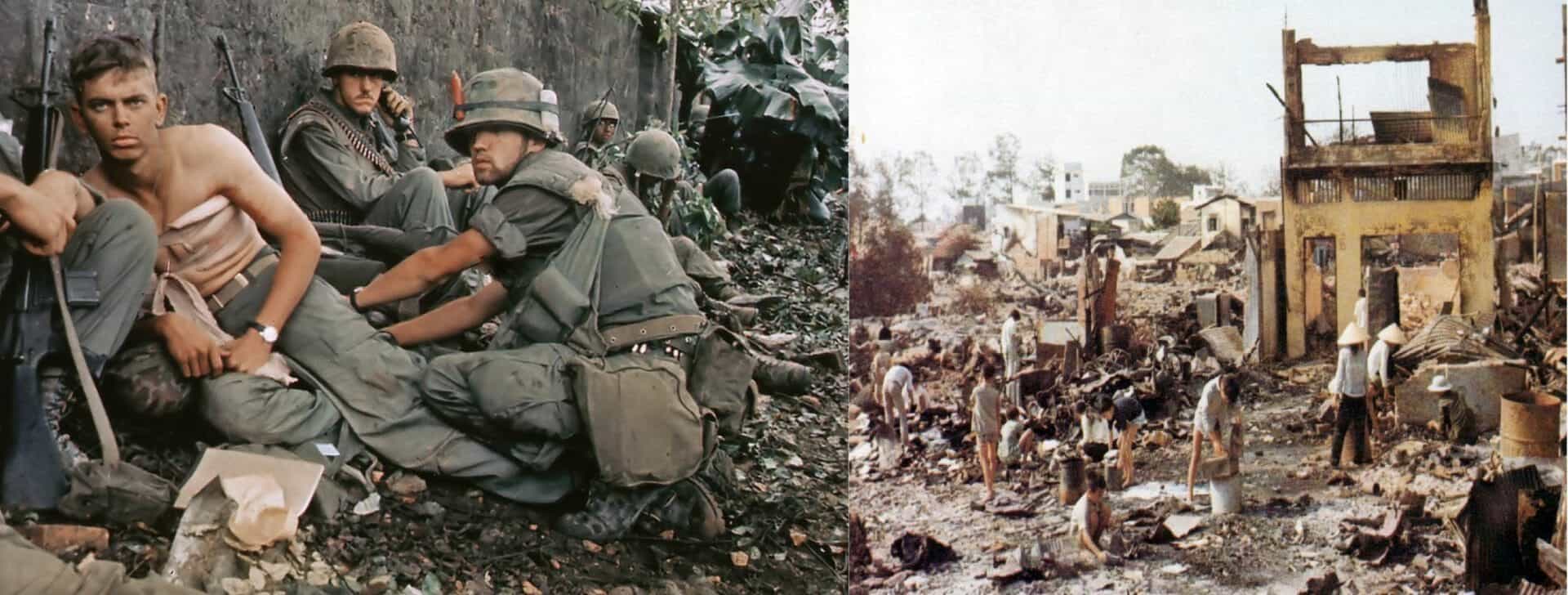│By Torsti Grönberg, Gale Ambassador at the University of Helsinki│
On August 30, 2021, the United States Armed Forces completed their withdrawal from Afghanistan. History rarely repeats, but it does rhyme. The fall of Kabul to the Taliban and the following airlift of allied personnel out of the city reminded me keenly of the Fall of Saigon, now called Ho Chi Minh City, to the North Vietnamese on May 30, 1975. The parallels between the ends of these armed conflicts seem endless and the images of desperate Afghans crowding the Kabul airport bring with them a sense of déjà vu. In this blog post I will showcase the usefulness of Gale’s US Declassified Documents Online archive and examine the trail of breadcrumbs left by declassified US documents dated shortly before the Fall of Saigon, during the Vietnam War. What was the US government focusing on? Who was President Gerald Ford writing to? What kinds of reports and memos were landing on Secretary of State Henry Kissinger’s desk?
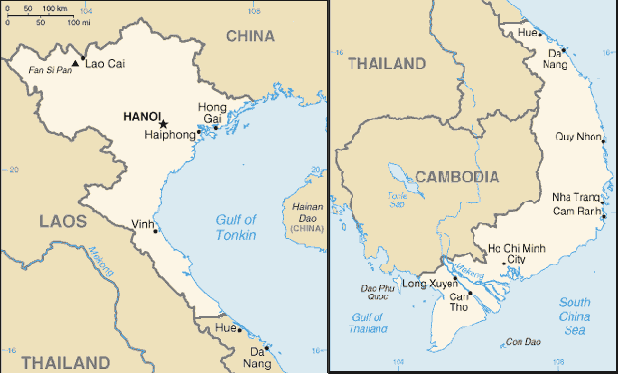
Left: https://commons.wikimedia.org/wiki/File:NoordVietnamKaart.png
Right: https://commons.wikimedia.org/wiki/File:ZuidVietnamKaart.png
The South Vietnamese Economy
I wanted to hone in on the documents that were dated just before the Fall of Saigon to see what these documents could tell me about this short time period, so I searched for documents between January 1, 1975 and May 31, 1975 from Gale’s US Declassified Documents Online archive. My search produced interesting results and I will examine the most fascinating of them in chronological order.
The first document is a 32-page memorandum to Secretary of State Henry Kissinger about the South Vietnamese economy and US aid. According to this document, the South Vietnamese economy had fared relatively well compared to expectations and adjusted well to the withdrawal of US troops and declining aid levels. Although the memo does indicate that the need for substantial economic aid will continue to be necessary for the next decade and that the encouraging economic trends depended on the continuation of the military stalemate between North and South Vietnam.
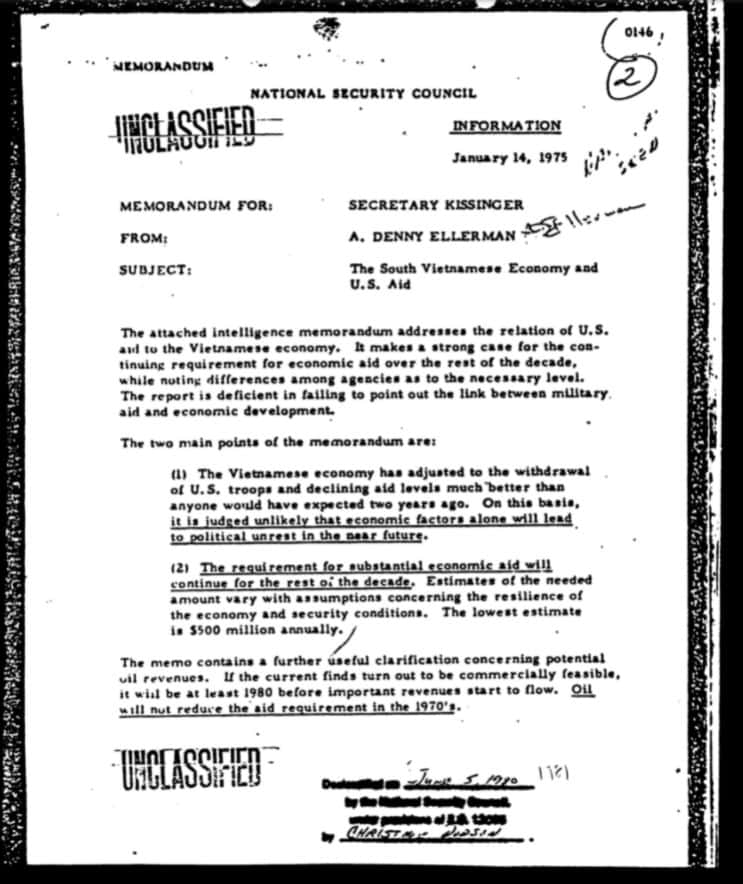
South Vietnamese economy and U.S. aid discussed. National Security Council, 14 Jan. 1975. U.S. Declassified Documents Online, https://link.gale.com/apps/doc/CK2349192174/USDD?u=uhelsink&sid=bookmark-USDD&xid=c03ca6cc&pg=1
Global Perception of the Conflict – Leaflets in Sweden
On the same day, Kissinger also received a message from US Ambassador Robert Strausz-Hupe informing him of the distribution of around 250,000 leaflets in Stockholm and four other Swedish cities appealing for humanitarian aid for children suffering in South Vietnam. The appeal for aid was issued by the South Vietnamese Information Office in Stockholm and also included the following text: “Why has Sweden only wanted to aid the communist dictatorship in North Vietnam which is fighting a war of aggression against the country and people of South Vietnam?” The message also details the Swedish response to the campaign and the hostile tone of the newspaper Aftonbladet in its reporting on these leaflets and makes the point that an effort has been made to keep the appeal as humanitarian as possible – focusing on the suffering of South Vietnamese children instead of Northern aggression seems a good way to do so. It is fascinating to see how important foreign relations and the global perception of the conflict were to the US government at the time.
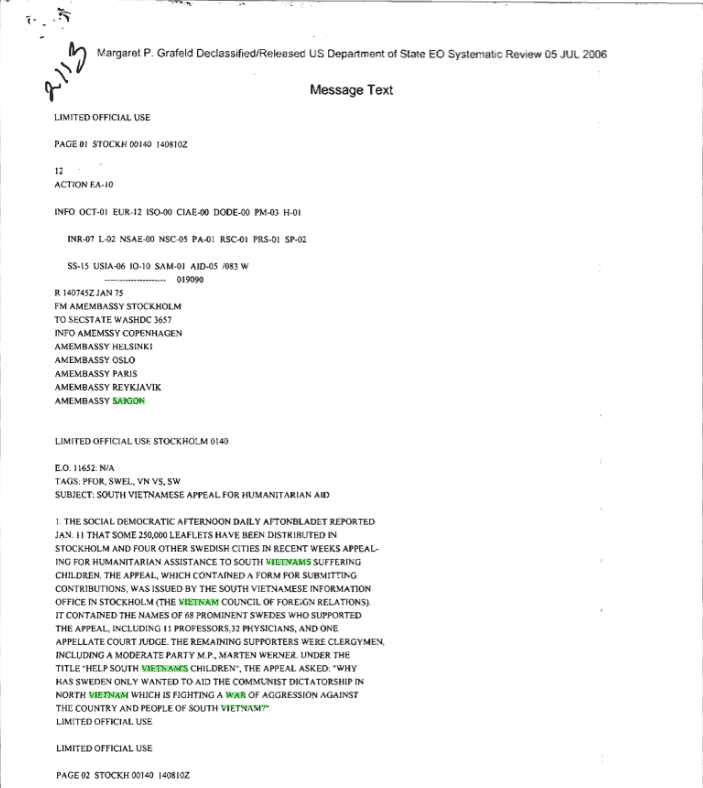
U.S. Ambassador Robert Strausz-Hupe informs Secretary of State Henry Kissinger of the distribution of some 250,000 leaflets in Stockholm and four other Swedish cities appealing for humanitarian assistance to South Vietnam. Department Of State, 14 Jan. 1975. U.S. Declassified Documents Online, https://link.gale.com/apps/doc/CK2349651331/USDD?u=uhelsink&sid=bookmark-USDD&xid=aa3221b7&pg=1
Hot off the Press in China and South Vietnam
The focus on the foreign press continues as on January 29, 1975 Kissinger receives a message with information on Chinese media reaction to the current North Vietnamese offensive in South Vietnam’s Phuoc Long province. The PRC media had thus far refrained from commenting on the communist offensive but in the first comment on Vietnam that year the NCNA (Chinese news agency) condemned the South Vietnam regime for repeated violations of the Paris Peace Accords and frames the communist offensive as a counterattack in self-defence. The piece only predicts that Saigon will continue to suffer defeats if they continue to break the Paris agreement. This lukewarm response is seen as a possible further indication of strain in the Hanoi-Peking relationship.
On March 18, 1975 Deputy Chief of Mission Wolfgang Lehmann provides Kissinger with details of South Vietnamese press coverage of the North Vietnamese offensive in South Vietnam. A US Congressional delegation visit dominated coverage through March 10, but some newspapers like Dan Chu and Tien Tuyen devoted front page coverage to reports of simultaneous North Vietnamese attacks in Kontum and Quang Ngai provinces on March 2, 1975. By March 15, news of the North Vietnamese offensive dominated the front pages of all Saigon dailies and two newspapers published eyewitness reports of people’s courts and executions taking place in newly captured areas taken by the communists.
A Letter from President Ford
On March 25, 1975 President Gerald Ford wrote a letter to Nguyen Van Thieu, President of the Republic of Vietnam. In this letter President Ford congratulates Thieu on his determination, resolution and courage and relays his conviction that in the end the South Vietnamese people will be successful in their fight to retain their freedom and independence. President Ford assures Thieu that the American commitment to South Vietnam is as strong as ever and that his government’s firm intention is to ensure the Republic of Vietnam’s economic viability and capability to defend itself.
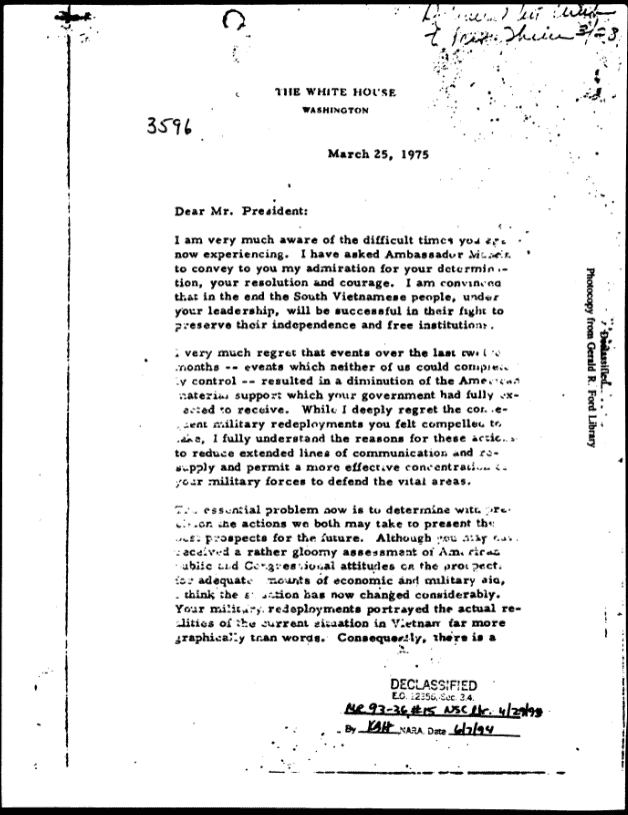
Letter from President Ford to Nguyen Van Thieu, President of the Republic of Vietnam, regarding the Vietnam war and U.S.-Vietnamese relations. White House, 25 Mar. 1975. U.S. Declassified Documents Online, https://link.gale.com/apps/doc/CK2349044909/USDD?u=uhelsink&sid=bookmark-USDD&xid=f2f356a2&pg=1
Reports of Fighting on the Outskirts of Saigon
The last document available to me from this time period (January 1, 1975 – May 31, 1975) is a Central Intelligence briefing in preparation for a Washington Special Actions Group meeting on the situation in Vietnam. According to the briefing, the fighting had now reached Saigon itself. North Vietnamese troops, with tank and artillery support, conducted heavy attacks over that weekend, and east of the capital communist forces had captured the province of Phuoc Tuy and large parts of Bien Hoa province. In the west the North Vietnamese were attacking Tan An, the capital of Long An Province. The Briefing details South Vietnamese troop movements and goes on to report that General Duong Van Minh assumed the presidency and had called for a cease-fire.
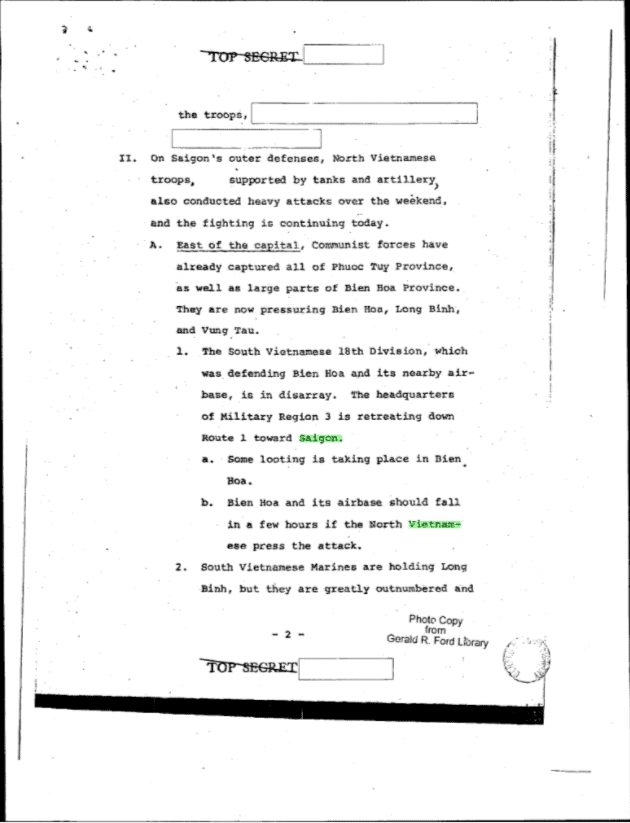
Director, Central Intelligence (DCI) briefing in preparation for a 10:38 a.m. Washington Special Actions Group (WSAG) meeting on the situation in Vietnam. Issues include: reports of fighting in the outskirts of Saigon, South Vietnam; North Vietnamese heavy attacks on Saigon’s outer defenses; General Duong Van Minh’s assumption of the presidency in South Vietnam and his call for a cease-fire. Central Intelligence Agency, 28 Apr. 1975. U.S. Declassified Documents Online, https://link.gale.com/apps/doc/CK2349587234/USDD?u=uhelsink&sid=bookmark-USDD&xid=7332cc8f&pg=1
The Importance of Primary Sources
As I hope the above glimpses into the past demonstrate, primary sources are invaluable if we want to research historical periods, institutions or regimes. Primary sources give us a window into the past and let us examine what information the individuals involved were basing their actions on – what meetings were being held, who was attending these meetings and what was on the agenda. For example, if you wanted to research which international newspapers the US government at the time considered important or influential, a good place to start would be to see which international newspapers were considered important enough to feature in US State Department memorandums that year. Gale’s US Declassified Documents Online archive is a rich resource for everyone who wants to get their hands on declassified documents in order to take their research to the next level.
If you enjoyed reading about classified documents, political or military history, you might like:
- The Assad regime in Syria: Exploring Topics in the News with U.S. Declassified Documents Online
- “U.S. Disavows Apology, Then Signs It” – The Pueblo Incident of 1968
- Declassified Documents Online: Twentieth-Century British Intelligence, An Intelligence Empire
- Humanity and Courage: Refugees and the Memory of Those Who Saved Them
- A Peep into Finnish War History with Gale Primary Sources
- Sir Bertram Ramsey – Britain’s Unsung War Hero
- When the Past Comes A-knocking – Why We Shouldn’t Forget About the Wars
Blog post cover image citation: Both images come from the Vietnam War Wikipedia page: https://en.wikipedia.org/wiki/Vietnam_War. Left: A marine gets his wounds treated during operations in Huế City, in 1968. (https://commons.wikimedia.org/wiki/File:OperationHueCity1967wounded.jpg) and Right: Cholon after Tet Offensive operations 1968 (https://commons.wikimedia.org/wiki/File:Cholon_after_Tet_Offensive_operations_1968.jpg).

